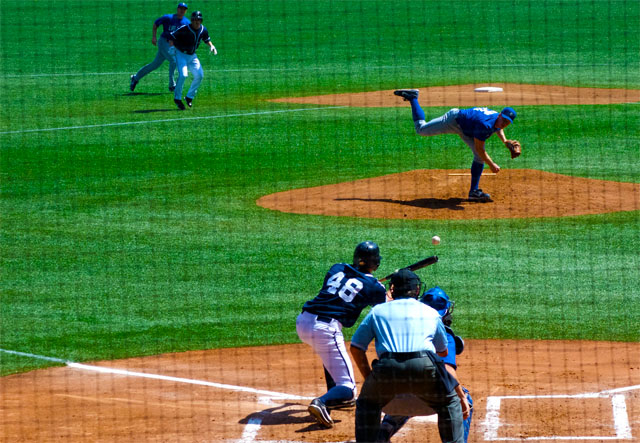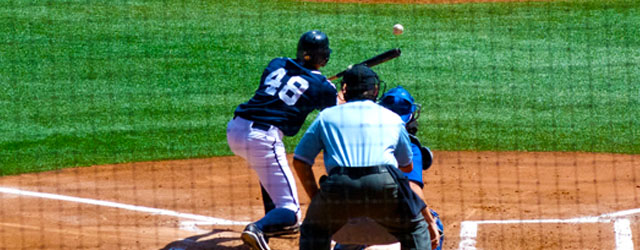 The squeeze bunt is the ultimate sacrifice bunt. You’re not looking to just advance the runner from one base to another. You are looking to score a run. Ultimate responsibility is placed on the hitter to get the ball on the ground and in fair territory. It can be used in a number of different situations, but always involves a runner on third with less than two outs. Most teams or coaches will only use the squeeze play late in the game to score a run for one of three reasons:
The squeeze bunt is the ultimate sacrifice bunt. You’re not looking to just advance the runner from one base to another. You are looking to score a run. Ultimate responsibility is placed on the hitter to get the ball on the ground and in fair territory. It can be used in a number of different situations, but always involves a runner on third with less than two outs. Most teams or coaches will only use the squeeze play late in the game to score a run for one of three reasons:
- To tie the game
- To score a go ahead run
- To score an insurance run
These are the most common uses for the squeeze bunt, but a creative coach can also use the squeeze play to spark a big inning earlier in the game. Here are some unconventional ways to use the squeeze play in the earlier innings of a ballgame:
- Against a new reliever who has just entered the game – Most relievers are just worried about not giving up a big hit that will score the runner from third. An unexpected squeeze can get you that run and rattle the new pitcher almost immediately.
- After a triple – A triple is the most exciting play in baseball. After the play is over, the crowd is usually still buzzing with excitement, the opposing pitcher is still thinking about the previous pitch he just threw, and nobody within 25 miles of the ballpark is thinking about a squeeze. The element of surprise is on your side. A great option especially if you are playing on your home field.
- After a successful double steal – Once again, most people in the ballpark will assume you just wanted to stay out of the double play, including the opposing coach and players. Once again, surprise is on your side and you can plate a much needed run and turn momentum in your favor.
Execution of the Squeeze Play
No matter the situation, whether conventional or not, the squeeze bunt only works if the execution is perfect. It is a high risk play and can swing momentum of the game against you as easily as it can help you. Coaches can employ one of two tactics when it comes to the squeeze play: the suicide squeeze or the safety squeeze. Let’s discuss the responsibility of both hitter and runner in each situation.
Players’ Responsibilities
First and foremost, everyone has to be on the same page: coach, runner, and hitter. You would think this is a given, but I cannot tell you how many times someone misses the sign and the play is doomed from the beginning. To combat this, there needs to be a sign in place that let’s the runner and coach know that the hitter received the sign. It can be a tip of the helmet, hitting the cleats with the bat, adjusting the batting gloves, or just about anything. Once the sign from the coach has been given, and the hitter and runner have acknowledged that they have received the sign, it’s time to execute.
The Hitter’s Responsibility
The responsibility of the hitter is fairly simple, yet he can still ruin the play if he is not perfect. As mentioned before, he is performing a sacrifice bunt. He is giving himself up in exchange for the run. We do not care about him being safe at first. This is extremely important for the hitter to understand, and must be stressed to the younger player who may only care about getting on base. Therefore, we want the hitter to stay in the box as long as needed to see the bunt down on the ground. A bunted ball that goes in the air is easily caught and ineffective in trying to score the runner.
Furthermore, the hitter should not square around to bunt until the last possible moment. Showing his intentions early can alert the opposing pitcher and he can throw the pitch in a more difficult spot to bunt, or he can throw at the hitter to cause a dead ball and return the runner to third.
Key Points:
-Show bunt as late as possible.
-Bunt the ball on the ground and down the first or third base line. Keep it out of the air.
-Stay in the batter’s box and see the ball down on the ground. You are not bunting for a hit.
-For a safety squeeze, make sure you get a good pitch to bunt. Make sure it’s a quality pitch that you can get on the ground.
-In a suicide squeeze situation, you absolutely have to bunt the ball whether it’s in the strike zone or not. The runner will be running home upon the pitcher committing to the plate, so you must get the bat on the ball to prevent him from being tagged out at home.
 The Runner’s Responsibility
The Runner’s Responsibility
For the runner, his responsibility changes depending on whether the coach is calling for a safety squeeze or a suicide squeeze. For the safety squeeze, the runner should get a good secondary lead and look for the ball to be bunted on the ground. As soon as he recognizes that the ball is on the ground, he should break for home. If he sees the ball go into the air, he should freeze and wait to see how the play develops.
In a suicide squeeze, the runner is effectively stealing home with the hopes that the batter puts the ball in play so he cannot be tagged out. It is an all or nothing play, hence the name. The runner should wait as long as possible before breaking for home so as to not give away the play. Leaving early can alert the opposing pitcher and he can thwart the squeeze play just as if the hitter squared around too early. A great way to gain ground down the line is to take a walking lead instead of a secondary lead.
Key Points:
-Do not break for home early.
-In a safety squeeze situation, see the ball to the ground before breaking for home.
-For a suicide squeeze, break for home at the last possible moment in the pitcher’s delivery.
-SLIDE! Whether the opposing team tries to make a play at home or not, hit the dirt with your feet first as you cross the plate. (Don’t worry, mom will wash your uniform for you.)
Final Thoughts
The squeeze play is a great weapon to have. Unfortunately, many teams simply do not practice its execution enough to give their coach confidence in calling it during a game. This particular play is something you will work on and practice multiple times throughout the season only to execute it in a game maybe once during a season. However, it could be the difference between a win or a loss.
Video – The squeeze executed to perfection.
Video – Failed squeeze play in extra innings.

Leave a Reply